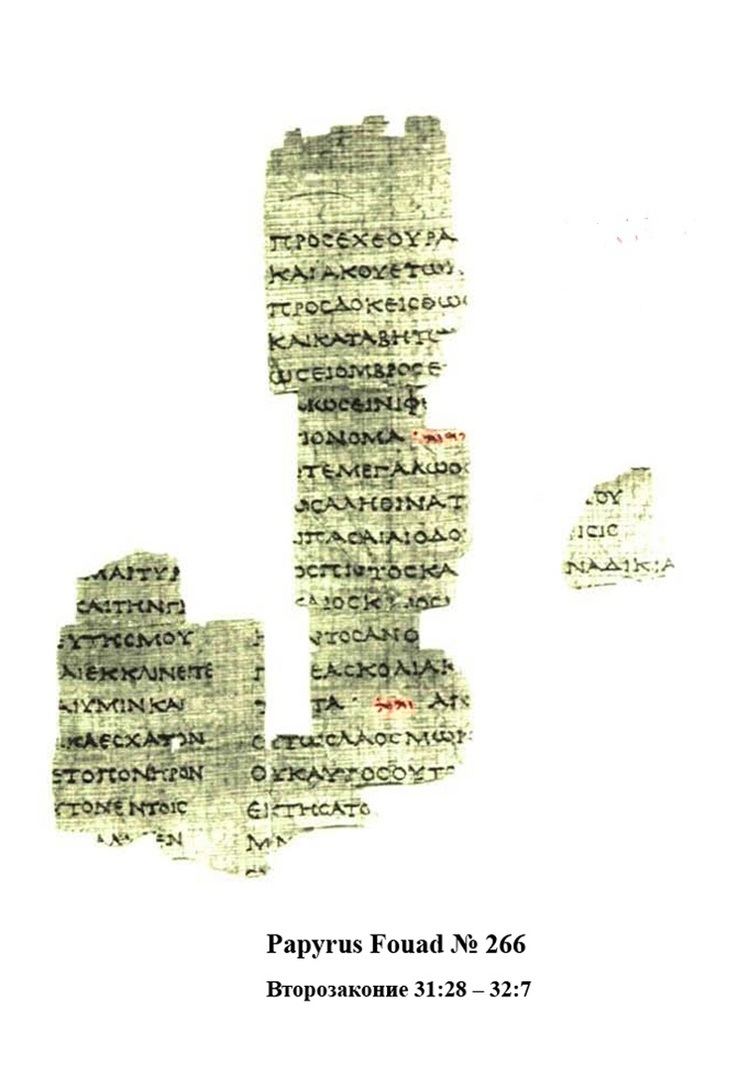 | ||
Papyrus Fouad 266 is a copy of the Pentateuch in the Greek version of the Hebrew Bible known as the Septuagint. It is a papyrus manuscript in scroll form. The manuscript has been assigned palaeographically to the 1st century BC. The manuscript has survived in a fragmentary condition. Discussion about this manuscript questions whether it is or is not a later recension of the standard Septuagint text.
Contents
Description
The Greek text was written on papyrus in uncial letters. The text is written in 33 lines per column. The uncial letters are upright and rounded. Iota adscript occurs. It is designated by number 847, 848, and 942, on the list of Septuagint manuscripts according to the modern numbering of Alfred Rahlfs. The surviving texts are fragments from Book of Deuteronomy, 31:28-32:6. It contains section divisions with numbered paragraphs (5, 26, 27). 117 papyrus fragments of the codex have survived.
The prefix Fouad commemorates Fouad I of Egypt.
It is the second oldest known manuscript of the Septuagint (Greek version of the Hebrew Bible), and the oldest which used the Hebrew Tetragrammaton in Aramaic "square" or Ashuri script, in following places: De 18:5, 5, 7, 15, 16; 19:8, 14; 20:4, 13, 18; 21:1, 8; 23:5; 24:4, 9; 25:15, 16; De 26:2, 7, 8, 14; 27:2, 3, 7, 10, 15; 28:1, 1, 7, 8, 9, 13, 61, 62, 64, 65; 29:4, 10, 20, 29; 30:9, 20; 31:3, 26, 27, 29; 32:3, 6, 19. In addition, in this collection the Tetragrammaton occurs three times in unidentified fragments, namely, in fragments 116, 117 and 123. This papyrus, found in Egypt, was dated to the first century B.C.E. This is an important piece of evidence for the Loss of the Tetragrammaton in the Septuagint debate.
The text of the manuscript runs close to the Old Greek text but it was characterized through correctors towards the Masoretic Text. In Deuteronomy 22:9 it agrees with the Masoretic Text. It is a witness of an early recension of the Old Greek text of Septuagint towards the Masoretic Text. Albert Pietersma was the first to claim that Fouad contains some pre-hexaplaric corrections towards a Hebrew text (which would have had the Tetragrammaton). Pietersma also states that there is room for the reading ΚΥΡΙΟΣ (The Lord), but the second scribe inserted the Tetragrammaton instead.
History of the Roll
Palaeographically the manuscript has been assigned to the 1st or even 2nd century BC. It is the second oldest manuscript of the Septuagint. It was discovered in 1939 in Fayyum, where there were two Jewish synagogues. The first published text from the manuscript was edited by William Gillan Waddell in 1944. In 1948 18 further fragments of the manuscript were published in 1950 in the New World Translation of the Christian Greek Scriptures. It was examined by Françoise Dunand and P. E. Kahle. In 1971 were published all 117 fragments of the manuscript. The manuscript currently is housed at the Societé Royale de Papyrologie (Gr. P. 458), Cairo.
